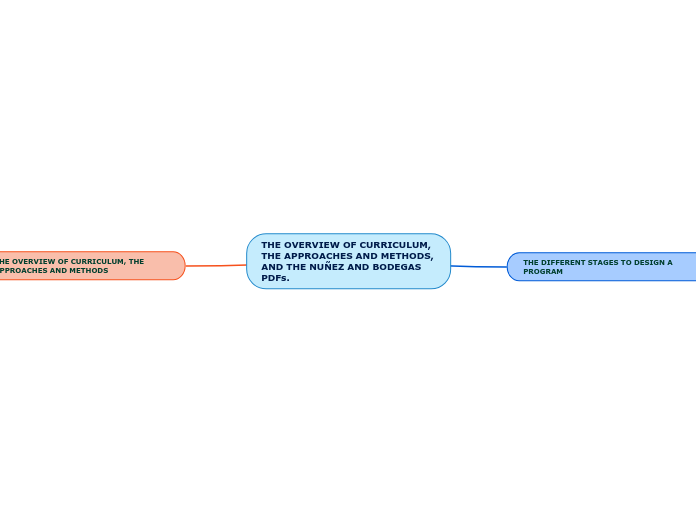THE OVERVIEW OF CURRICULUM, THE APPROACHES AND METHODS, AND THE NUÑEZ AND BODEGAS PDFs.
THE DIFFERENT STAGES TO DESIGN A PROGRAM

Syllabuses
Structural
Principles-sequenced
Grammatical
Phonological
Situational
Situations
Students will encounter
Topical
Topics or themes
Functional
Functions
Chronology
Notional
Conceptual categories
Skill
Skill such as
Listening for
gist
main ideas
Task
Activity-based

Shape of syllabus
Format
Lineal
Discrete
Not changes
Modular
Suited
Integrate courses
Cyclical
Organizational principle
Same topic
Matrix
Maximum flexibility
Random order
Story line
Narrative
THE OVERVIEW OF CURRICULUM, THE APPROACHES AND METHODS
Approach
Theory
Language:
Structural model
Structural elements
Codification of meaning.
Cognitive model
Reflects property of the mind
Functional model
Structure- grammar.
Interactional model
Interpersonal relationships.
Sociocultural model
Social context- central
Genre model
Narrative
Explanation
Descriptive
Lexical model
The role of
grammar
vocabulary

Learning
Behaviorism
Respond to specific stimuli
Cognitive-learning code
Learning
Inductive
Deductive
Creative cognition hypothesis
Based language teaching
Skill learning
Skill performane
Individual factors
Learning style references
Affective factors
Motivation
Constructivism
Own process of learning
Sociocultural
People different places
Interactional Theory
Mutual understanding

Design
General Objectives
Form Teachers
Master English´s teaching
Solid knowledge
Types of learning and teaches activities
Dramatical accuracy
Focus on communication skills
Mastering the characteristics of grammar
Audiolingualism
Learner roles
Contribution to the learning process
Degree
Subject mastery
Influence from others
Development of human values
Learner autonomy
Active processor of language
Teacher roles
Instructional system
Source of knowledge
Control the learning process
Model for example
The role of institutional material
Instructional system
Content terms of language elements
Structures
Topic
Functions
Subject matter content
Facilitate the comunication

Procedure
Classroom
Design
Behaviors Observed
Techniques
Strategies used
